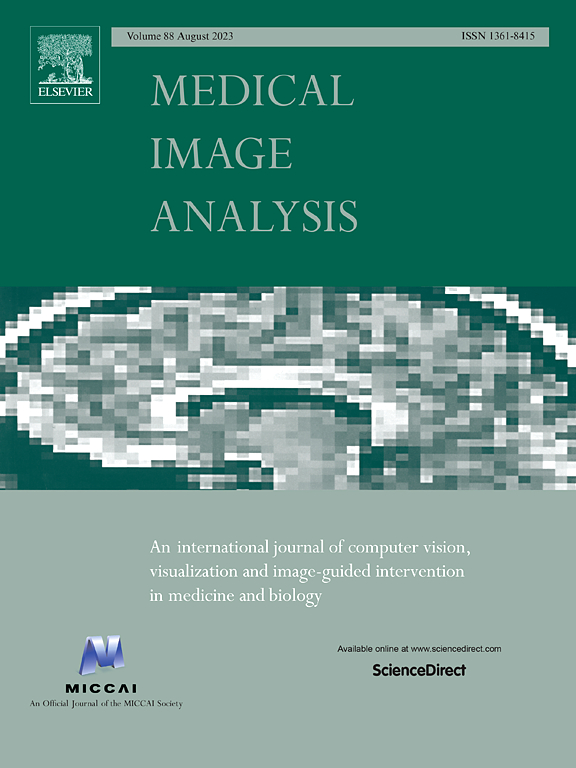Uncertainty-driven hybrid-view adaptive learning for fully automated uterine leiomyosarcoma diagnosis
IF 10.7
1区 医学
Q1 COMPUTER SCIENCE, ARTIFICIAL INTELLIGENCE
引用次数: 0
Abstract
Uterine leiomyosarcoma (ULMS) is a rare malignant tumor of the smooth muscle of the uterine wall that is aggressive and has a poor prognosis. Accurately and automatically classifying histopathological whole-slide images (WSIs) is critical for clinically diagnosing ULMS. However, few works have investigated automated ULMS diagnosis methods due to its high degrees of concealment and phenotype diversity. In this study, we present a novel uncertainty-driven hybrid-view adaptive learning (UHAL) framework to efficiently capture the distinct features of ULMS by mining pivotal biomarkers at the cell level and minimizing the redundancy from hybrid views under an uncertainty discrimination mechanism, ultimately ensuring reliable diagnoses of ULMS WSIs. Specifically, hybrid-view adaptive learning incorporates three modules: phenotype-driven patch self-optimization to select salient patch features, unsupervised inter-bags adaptive learning effectively filters out redundant information, and compensatory inner-level adaptive learning further refines tumor features. Furthermore, the uncertainty discrimination mechanism achieves enhanced reliability by assigning quantitative confidence coefficients to predictions under the Dirichlet distribution, leveraging uncertainty to update the features for obtaining accurate diagnoses. The experimental results obtained on the ULMS dataset indicate the superior performance of the proposed framework over that of ten state-of-the-art methods. Extensive experimental results obtained on the TCGA-Esca, TCGA-Lung, and Spinal infection datasets further validate the robustness and generalizability of the UHAL framework.
不确定性驱动的混合视图自适应学习用于全自动子宫平滑肌肉瘤诊断
子宫平滑肌肉瘤(ULMS)是一种罕见的子宫壁平滑肌恶性肿瘤,具有侵袭性,预后差。准确、自动分类组织病理学全片图像(wsi)是临床诊断ULMS的关键。然而,由于其高度隐蔽性和表型多样性,很少有研究自动ULMS诊断方法。在这项研究中,我们提出了一种新的不确定性驱动的混合视图自适应学习(UHAL)框架,通过在细胞水平上挖掘关键生物标志物,并在不确定性判别机制下最大限度地减少混合视图的冗余,从而有效地捕捉ULMS的独特特征,最终确保对ULMS wsi的可靠诊断。具体而言,混合视图自适应学习包含三个模块,表型驱动的斑块自优化选择显著的斑块特征,无监督的袋间自适应学习有效过滤冗余信息,代偿性内部自适应学习进一步细化肿瘤特征。此外,不确定性判别机制通过为Dirichlet分布下的预测分配定量置信系数来提高可靠性,利用不确定性更新特征以获得准确诊断。在ULMS数据集上获得的实验结果表明,所提出的框架优于十种最先进的方法。在TCGA-Esca、TCGA-Lung和脊柱感染数据集上获得的大量实验结果进一步验证了UHAL框架的鲁棒性和泛化性。
本文章由计算机程序翻译,如有差异,请以英文原文为准。
求助全文
约1分钟内获得全文
求助全文
来源期刊

Medical image analysis
工程技术-工程:生物医学
CiteScore
22.10
自引率
6.40%
发文量
309
审稿时长
6.6 months
期刊介绍:
Medical Image Analysis serves as a platform for sharing new research findings in the realm of medical and biological image analysis, with a focus on applications of computer vision, virtual reality, and robotics to biomedical imaging challenges. The journal prioritizes the publication of high-quality, original papers contributing to the fundamental science of processing, analyzing, and utilizing medical and biological images. It welcomes approaches utilizing biomedical image datasets across all spatial scales, from molecular/cellular imaging to tissue/organ imaging.
 求助内容:
求助内容: 应助结果提醒方式:
应助结果提醒方式:


